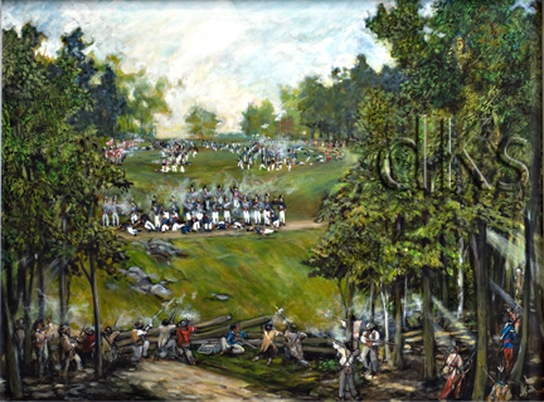
"The Company of Coloured Men"(The Battle of Queenston Heights)
The Coloured Corps saw action in some of best-known battles of the War of 1812. At the Battle of Queenston Heights, they participated in the recapture of the Redan Battery after the death of Major General Brock. Captain Runchey's Company of Coloured Men was a militia company of free and indentured Negro servants of the Niagara peninsular who feared an American invasion and were anxious to preserve their freedom and prove their loyalty to Britain. They fought gallantly for the British and Canada during the early part of the Anglo-American War of 1812.
The company was formed at the instigation of a black settler in Upper Canada, Richard Pierpoint, who had served as part of Butler's Rangers during the American Revolutionary War. On the outbreak of the War of 1812, he petitioned Major General Isaac Brock, commanding the British forces in Upper Canada, to form a militia corps from black settlers in the Niagara Peninsula. For unknown reasons, Brock initially turned down Pierpoint's request. However by July, Brock was desperate for volunteer troops, who at that point were not coming forward from among the white population. He set in motion the very plan that Pierpoint had suggested a month before.
At the Battle of Queenston Heights, they participated in the recapture of the Redan Battery after the death of Major General Brock. Their positioning in the battle of Queenston Heights suggests that the Coloured Corps was considered to be light infantry. Light infantry troops were much more mobile and given more freedom in terms of selecting targets, often targeting officers as a way of creating as much havoc among the enemy as possible. The Coloured Corps suffered no casualties in the battle although the 1st Lincoln Militia (of which the Coloured Corps was part did suffer one man killed and two wounded.
Medium: Acrylic
Image Size 24”x 30”
The Coloured Corps saw action in some of best-known battles of the War of 1812. At the Battle of Queenston Heights, they participated in the recapture of the Redan Battery after the death of Major General Brock. Captain Runchey's Company of Coloured Men was a militia company of free and indentured Negro servants of the Niagara peninsular who feared an American invasion and were anxious to preserve their freedom and prove their loyalty to Britain. They fought gallantly for the British and Canada during the early part of the Anglo-American War of 1812.
The company was formed at the instigation of a black settler in Upper Canada, Richard Pierpoint, who had served as part of Butler's Rangers during the American Revolutionary War. On the outbreak of the War of 1812, he petitioned Major General Isaac Brock, commanding the British forces in Upper Canada, to form a militia corps from black settlers in the Niagara Peninsula. For unknown reasons, Brock initially turned down Pierpoint's request. However by July, Brock was desperate for volunteer troops, who at that point were not coming forward from among the white population. He set in motion the very plan that Pierpoint had suggested a month before.
At the Battle of Queenston Heights, they participated in the recapture of the Redan Battery after the death of Major General Brock. Their positioning in the battle of Queenston Heights suggests that the Coloured Corps was considered to be light infantry. Light infantry troops were much more mobile and given more freedom in terms of selecting targets, often targeting officers as a way of creating as much havoc among the enemy as possible. The Coloured Corps suffered no casualties in the battle although the 1st Lincoln Militia (of which the Coloured Corps was part did suffer one man killed and two wounded.
Medium: Acrylic
Image Size 24”x 30”
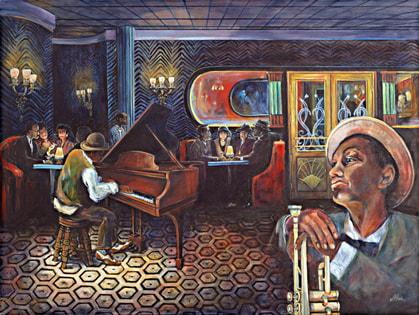 The Weary Blues 36" x 48" acrylic
CLICK ON IMAGE TO VIEW VIDEO
The Weary Blues 36" x 48" acrylic
CLICK ON IMAGE TO VIEW VIDEO
The Weary Blues the painting
By Dennis K. Smith
Summary: "The Weary Blues" takes place at an old Harlem bar on Lenox Avenue. There is a piano player playing the blues. As he plays, the speaker observes his body movement and the tone of his voice. Throughout the poem, several literary devices are used to guide the reader through the mixture of emotions the blues player is feeling. With its diction, its repetition of lines and its inclusion of blues lyrics, the poem evokes the mournful tone and tempo of blues music giving the reader a more personal glimpse into the life of the man playing the blues
How this painting came to be.
One night I came across a recording of Langton’s Hughes’ The Weary Blues produced by Four Season Productions. As I listened to the reciting of the poem I began to visualize the scene. This painting is the result of the scene that materialized and came to be while listening to the descriptive words of the poet.
By Dennis K. Smith
Summary: "The Weary Blues" takes place at an old Harlem bar on Lenox Avenue. There is a piano player playing the blues. As he plays, the speaker observes his body movement and the tone of his voice. Throughout the poem, several literary devices are used to guide the reader through the mixture of emotions the blues player is feeling. With its diction, its repetition of lines and its inclusion of blues lyrics, the poem evokes the mournful tone and tempo of blues music giving the reader a more personal glimpse into the life of the man playing the blues
How this painting came to be.
One night I came across a recording of Langton’s Hughes’ The Weary Blues produced by Four Season Productions. As I listened to the reciting of the poem I began to visualize the scene. This painting is the result of the scene that materialized and came to be while listening to the descriptive words of the poet.
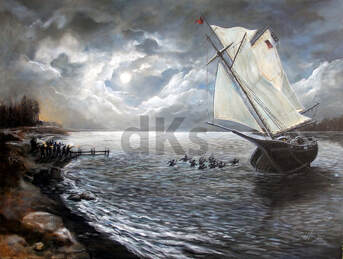
Probably the most striking incident that has occurred in Amherstburg since the War of 1812 was the capture of the Patriots’ schooner ANNE on the night of January 9, 1838.
In an attempt of the Patriots to capture the military post at Malden they had armed the schooner ANNE with three cannons and had harassed the town for the two days previous to the final scene enacted at Elliott’s Point when the victorious militia captured the daring vessel and its crew. This painting depicting the capture is part of the Artists of Colour's Journeys 2 "The Never-Ending Quest for Inclusion "exhibit.
The Capture of Schooner Anne
Medium: acrylic image size 36" x 48"
Probably the most striking incident that has occurred in Amherstburg since the War of 1812 was the capture of the Patriots’ schooner ANNE on the night of January 9, 1838.
In an attempt of the Patriots to capture the military post at Malden they had armed the schooner ANNE with three cannons and had harassed the town for the two days previous to the final scene enacted at Elliott’s Point when the victorious militia captured the daring vessel and its crew. This painting depicting the capture is part of the Artists of Colour's Journeys 2 "The Never-Ending Quest for Inclusion "exhibit.
The Capture of Schooner Anne
Medium: acrylic image size 36" x 48"
“Preparing the Stew”
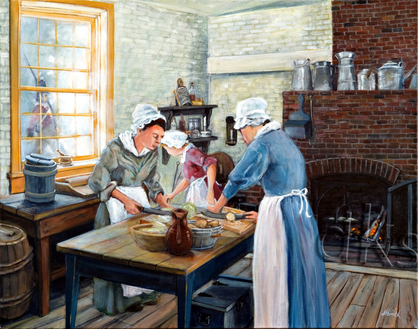
Married soldiers of 1812 apart from the company messes, were usually permitted to pool their rations with their families, however if, a wife could not provide for herself and her children and was "found to encroach on the man's subsistence", the soldier was placed in a mess and the woman turned away. As a preventative measure, the army issued a half ration of food to each woman and a quarter ration to each child. These rations were limited to twelve women and their children per company.
“Preparing the Stew”
In this painting three women combine their rations to serve up a hearty vegetable stew accompanied with hot grilled biscuits. Then to make the meal special, a small serving of stewed fruit will follow.
A visit to cookhouse at Fort Malden National Historic Site served up the inspiration for this painting.
Medium: Acrylic Image size: 28” x 22”
"Preparing the Stew" was entered into the Destiny Exhibit held at the Gibson and received first place honour by the Destiny Art Committee as best representing the theme "the strength of the people"
“Preparing the Stew”
In this painting three women combine their rations to serve up a hearty vegetable stew accompanied with hot grilled biscuits. Then to make the meal special, a small serving of stewed fruit will follow.
A visit to cookhouse at Fort Malden National Historic Site served up the inspiration for this painting.
Medium: Acrylic Image size: 28” x 22”
"Preparing the Stew" was entered into the Destiny Exhibit held at the Gibson and received first place honour by the Destiny Art Committee as best representing the theme "the strength of the people"
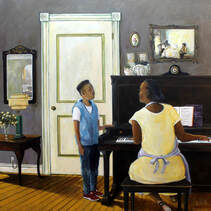
Remembering the days of preparing a song to sing to my father when he arrived home from work. My mothers' delight was found in music, playing the piano supplied those times where she set aside the cooking, cleaning and go over the hymns for Sunday service. The sound of music was constant in our home and sometimes it was accompanied by small voices.
“SONGBIRD”
artist Dennis K. Smith
Medium: acrylic on 1 ½ inch gallery style canvas.
Size:30” x 30”
CLICK ON IMAGE TO VIEW VIDEO
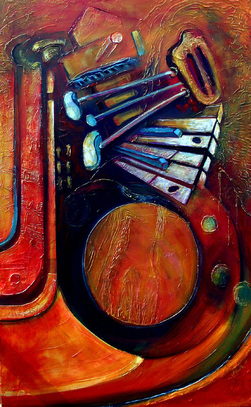 The Music Within
The Music Within
THE MUSIC WITHIN the first of the Series
If Art is a visual language and music the voice of the soul, then my canvas shall be the platform upon which I'll sing! .................. dKsmith
My mother was a gifted musician and my Father a preacher. If my mother wasn't playing her bass guitar or piano, records would be spinning while she worked. The piano was her voice, in sickness she would make it to the piano and songs of worship would pour out. My siblings and I were encouraged to learn to play an instrument. So it was that I endeavored to play the trumpet, I later picked up the guitar, harmonica, and piano. I leant enough on these instruments to play a song or two a song but never really mastered any but I can still say I still have the music within.
Within this painting are the above four instruments. They are painted with intense passionate colours to represent the seductive and unbridled energy music can release. My acoustic guitar rests upon an old wooden easel while the other instruments rhythmically weave their way through each other.
Medium: Acrylic on Canvas
Image Size; 24” x 36”
Click on Image to View The Music Within exhibit
